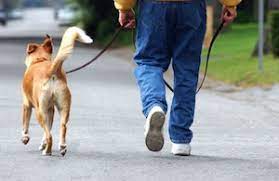
Paws on the street’ makes high-trust areas safer, study finds.
If you want to find a safe neighborhood to live in, choose one where the residents trust each other – and have a lot of dogs to walk.
Researchers from Ohio State University conducted a study that demonstrated that neighborhoods with more dogs had lower rates of homicide, robbery and, to a lesser extent, aggravated assaults compared to areas with fewer dogs, at least when residents also had high levels of trust in each other.
The results suggest that people walking their dogs puts more “eyes on the street,” which can discourage crime. 
“People walking their dogs are essentially patrolling their neighborhoods,” said lead author Nicolo Pinchak. “They see when things are not right, and when there are suspect outsiders in the area. It can be a crime deterrent.” The study was published recently in the journal Social Forces. “Sociologists have long theorized that a combination of mutual trust and local surveillance among residents of a neighborhood can deter criminals,” said study co-author Christopher Browning, a professor of sociology at Ohio State. But there hasn’t been a good measure of how residents provide surveillance of neighborhood streets. “We thought that dog walking probably captures that pretty well, which is one reason why we decided to do this study.”
For the study, researchers looked at neighborhood crime statistics in the Columbus area. They obtained survey data from a marketing firm that asked Columbus residents if they had a dog in their household. Finally, they used data from the Adolescent Health and Development in Context study which measured trust in individual neighborhoods. As part of that study, residents were asked to rate how much they agreed that “people on the streets can be trusted” in their neighborhoods.
Research has shown that trust among neighbors is an important part of deterring crime, because it suggests residents will help each other when facing a threat and have a sense of “collective efficacy” that they can have a positive impact on their area. Results of this study showed, as expected, that neighborhoods with high levels of trust had lower levels of homicide, robbery and aggravated assaults when compared to neighborhoods with low levels of trust. Interestingly, among high-trust neighborhoods, those with high concentrations of dogs showed an additional drop in crime compared to those with low concentrations of dogs.
It really has to do with the dog walking.
“Trust doesn’t help neighborhoods as much if you don’t have people out there on the streets noticing what is going on. That’s what dog walking does,” Pinchak said. And that’s why dogs have a crime-fighting advantage over cats and other pets that don’t need walking. “When people are out walking their dogs, they have conversations, they pet each other’s dogs. Sometimes they know the dog’s name. They learn what’s going on and can spot potential problems.”
The study found that more dogs in a neighborhood was also related to fewer property crimes, like burglaries, irrespective of how much residents trust each other. That’s because barking and visible dogs can keep criminals away from buildings where the dogs are found – and neighborhood trust and surveillance is not needed as a factor, as it is in street crimes. The protective effect of dogs and trust was found even when a wide range of other factors related to crime was taken into account, including the proportion of young males in the neighborhood, residential instability and socioeconomic status.
Overall, the results suggest that it is beneficial to have a lot of trust in your neighbors to prevent crime – particularly if you add a lot of dogs and dog walkers.
“There has already been a lot of research that shows dogs are good for the health and well-being of their human companions,” Pinchak said.
“Our study adds another reason why dogs are good for us.”
[Link]
